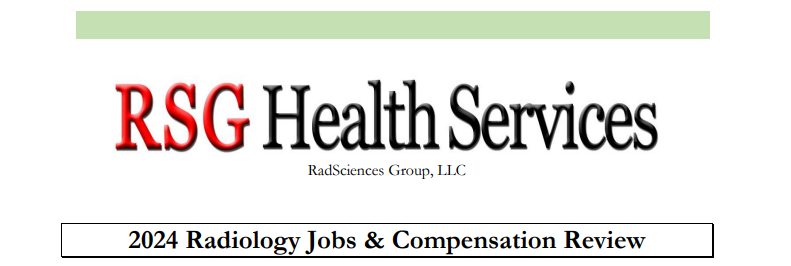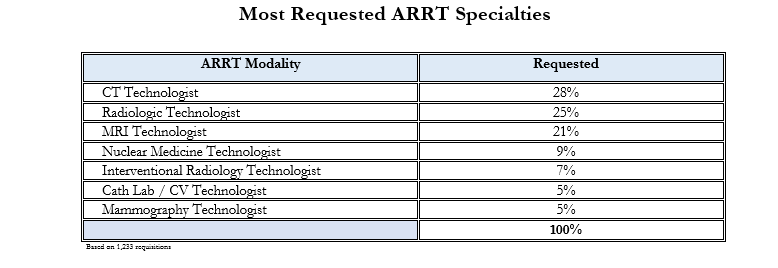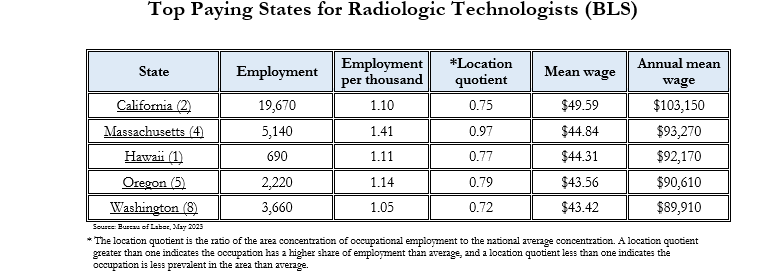

Contents
- Summary of the Radiology Jobs & Compensation Review ……………………………………………………………………………………………………………………………………………………….
- Gender of Candidates ……………………………………………………………………………………………………………………………………………………….
- Offers Made by Years of Experience ……………………………………………………………………………………………………………………………………………………….
- Wages Medical Imaging / ARRT Specialties ……………………………………………………………………………………………………………………………………………………….
- Wages Medical Imaging / ARRT Specialties Cont. ……………………………………………………………………………………………………………………………………………………….
- Most Requested ARRT Specialties ……………………………………………………………………………………………………………………………………………………….
- Wages ARDMS Specialties ……………………………………………………………………………………………………………………………………………………….
- Most Requested ARDMS Specialties ……………………………………………………………………………………………………………………………………………………….
- Wages Cardiology Specialties ……………………………………………………………………………………………………………………………………………………….
- Bureau of Labor Data, Radiology Compensation ……………………………………………………………………………………………………………………………………………………….
- Regional Compensation Differences ……………………………………………………………………………………………………………………………………………………….
- Top Paying States for Radiologic Technologists (BLS) ……………………………………………………………………………………………………………………………………………………….
- Relocation & Bonus Incentives ……………………………………………………………………………………………………………………………………………………….
- Radiology Travel Sector ……………………………………………………………………………………………………………………………………………………….
- Work/Life Balance ……………………………………………………………………………………………………………………………………………………….
- Economic Conditions ……………………………………………………………………………………………………………………………………………………….
- About RSG Health Services ……………………………………………………………………………………………………………………………………………………….
Summary of the Radiology Jobs & Compensation Review
The 2024 Radiology Jobs & Compensation Review is based on the total number of full-time (permanent) job searches acquired by RSG Health Services between January 1, 2023, and December 31, 2023. The compiled compensation data discussed in this review are ARRT modalities including Radiography, Computed Tomography, Magnetic Resonance Imaging, Imaging Directors, Mammography, Nuclear Medicine, Interventional Radiology, and Cardiac Cath Lab. The review also includes common ARDMS modalities such as Ultrasound, Vascular, and Echocardiography. Similar to our previous reviews, the majority (88%) of the job searches represented in this review consist of hospital-based positions, with the remaining 12% being outpatient imaging based jobs. Additionally, thirty-three percent (33%) of searches conducted were for hospitals in cities with a population of less than 100,000 residents.
The wages shown in this report reflect the lowest, average (mean), and highest wage offered for each specialty group when combining all data received by our Human Resources and Talent Acquisition partners. The data does not include shift differential, bonuses, or overtime, only the base wage that was offered. Why is this important? Many of the third-party compensation surveys available to the public use survey platforms to collect data directly from providers. Therefore, their data might include pay provided by contract workers (travelers), which can be much different than a full-time worker. Provider surveys might also include overtime, bonuses, holiday pay and shift differential that may or may not be consistent. The goal of this compensation review is to provide data on full-time jobs and the starting base wages. As in our previous compensation reviews, outliers were also considered when compiling the data and removed when calculating the averages.
New hire appropriations such as relocation packages and sign-on bonuses remained consistent last year, as many employers still found it necessary to offer these incentives to entice job seekers to relocate to their respective service areas. While this has been a traditional practice for many years, we observed considerable increases in the amounts being offered over the past couple of years.
We also noticed an increase in the number of junior level technologists being offered jobs in both 2022 and 2023. While this might surprise some, in years past, some new graduates had difficulty finding work straight out of school. This led us to make note of the number of facilities offering jobs to new graduates or less experienced imaging providers this past year. This percentage increased from 21% in 2021, to 27% in 2022, and to 29% in 2023. While hiring new graduates is a common practice for some organizations, it is not always an option for many smaller facilities that are unable to offer additional training after a student graduates. Furthermore, since we are a recruiting firm, clients usually contact us because they need someone with experience who can come in and make an immediate impact in the department.
As of the writing of this review, the job market for medical imaging providers seems strong. While the travel/contract sector is still good, in a recent poll we conducted on LinkedIn, it is not nearly as lucrative now as it was the past couple of years. Our poll simply asked, “Compared to one-year ago, how lucrative are travel contracts today?” A whopping 74% believed temporary assignments are not as good as they were just a year ago. Of the remaining 26%, 17% indicated they believed it is about the same, and 9% believe it is better than a year ago. This is not to say the temporary staffing industry is suffering. However, providers are now seeing pay rates being cut, incentives disappearing, and rising temporary housing costs eat into their take home pay. Where some technologists have been extending contracts multiple times, some also indicated that hospitals are no longer renewing contracts.
As a permanent placement agency, we believe the need for full-time staff is at an all-time high. With the contract market seemingly starting to cool down, this is good news for employers who are welcoming them off the road. Our records show that many of our clients have increased wages, so this is also good news for medical imaging providers who are looking to settle down in a full-time role. There are many benefits to both full-time and contract jobs, so seeing wages increase by more than 20% in some modalities is very positive for our industry.
We also observed a 6% increase in the number of facilities who offered both relocation assistance and bonuses over the previous year. This is the third consecutive year we’ve noticed this increase. Since most hospitals find it necessary to recruit from outside their service area, offering relocation assistance and bonuses remains a necessary practice. These incentives can vary greatly by facility, but they could include sign-on bonuses, retention bonuses, relocation reimbursement, directly paying moving companies, and temporary housing.

Medical Imaging Wages
One important observation for 2023 was that for the first time in the 20 years we have been reviewing wages, more offers were made to younger technologists than senior level technologists. This could be for several reasons, but we are happy to note that new graduates are not having much difficulty securing employment like in years past. Especially, those who are willing to relocate for their first job. The low wage for Rad Techs came in at $23.40 per hour in 2023, which likely represents a new graduate rate. The highest rate offered was $40.10 per hour. Notably, our data reflects the mean starting wage for a Rad Tech in 2013 was $20.09 and $28.51 in 2023, indicating a 41.9% increase over the past ten years.
As noted in all our compensation reviews, all employers we work for calculate wages based on years of experience. This excludes school, clinical rotations, and other healthcare experiences that are unrelated to medical imaging. There seems to be little deviation from this practice, and wages can vary widely throughout the country. Obtaining higher education and additional certifications usually has no bearing on the wage being offered, even if the provider is working in multiple areas of imaging. Exceptions to this might be for management roles where it is commonly asked that directors have a master’s degree, CRA certification, or both. However, it is also our opinion that obtaining multiple certifications can make an imaging provider much more attractive in a competitive job environment. We would like to see imaging providers be paid “premium pay” based on the number of certifications they hold, but that is still yet to catch on as a common practice. Truthfully, we believe it could make a significant impact on organizations who need to hire technologists who can cover multiple service lines. We’ve developed a Compensation Checklist for facilities who are interested in this concept. It’s foolproof, justifiable, and eliminates the grey areas of why a new hire might be paid more, even if they have less years of experience in the profession as a current employee.

RSG Health Services will compare our data to other public sources as well. One of these sources, the ASRT, publishes wage data every three years. As we noted last year, the ASRT indicated in their June 2022 compensation report that the average salary of a Radiologic Technologist rose by 11.2% over the past three years, and now averages $77,027 ($37.03/hr). We have no insight into how the ASRT collects data, but we suspect it is a salary survey based on total compensation, not just the base wage. What we do know is that the ASRT sent questionnaires in February 2022 to all currently practicing ASRT members with an email address in the 50 states and the District of Columbia. A total of 10,775 radiologic technologists returned completed questionnaires, resulting in an 8% return rate. While there is good value in the ASRT report, our numbers only show the base wage and not overtime, on-call pay, shift differential, bonuses, or other factors that might be inconsistent and not guaranteed. However, their survey shows that all major disciplines in medical imaging increased since their last survey in 2019. Again, our data was collected from the Human Resources and Talent Acquisition Departments to determine only the base pay being offered.

In 2023, we had the most requests to recruit CT Technologists and Radiologic Technologists. Here is a breakdown of the most requested ARRT searches by our clients.

Notably, 74% of the recruiting requests were for Computed Tomography (CT), Radiography (R), and Magnetic Resonance Imaging (MR) Technologists. This statistic was almost identical to last year (73%), so this comes as no surprise. While the cath lab department sometimes falls into the areas of cardiology or cardiopulmonary, many Cardiovascular Techs are ARRT certified, so we include these individuals as part of our services.
For the most part, the mean wages remained steady or increased for a third consecutive year as the competition to recruit and retain imaging providers remains a high priority for healthcare organizations. In previous years, we reported only small increases or decreases in compensation. However, since the pandemic and the circumstances which occurred afterwards, many healthcare organizations found themselves in a bidding war to attract and retain workers. Whether this trend will continue is unclear, but we believe the largest wage adjustments have been made.

Strangely, the number of job requisitions we have received to recruit sonographers has decreased over the past two years. We do not read too much into this, as the demand is still considered high. The high earning potential combined with a great employment outlook still makes sonography a popular choice. Monster.com recently named sonography as the second-best paying job you can get with an associate degree, and U.S. News ranked it in the top five best allied health jobs. However, over the past two years we have seen a slight decrease in the demand to recruit Sonographers.

As always, the requests to recruit general Sonographers leads the way, as most employers seek individuals who can perform a variety or sonographic exams. This could include routine exams, vascular studies, and in some cases, echocardiography. When it comes to small facilities, the more you can do the better in many cases. We also saw a modest decrease in requisitions to recruit both Cardiac Sonographers and Vascular Sonographers in 2023. When a request to recruit these particular providers is made, it is usually for a clinic or large medical center with designated labs for echocardiography and vascular ultrasound. This makes up just a small percentage of our client base. As noted above, general sonographers are still the most in-demand and account for 72% of the ultrasound job requisitions, up from 66% in 2022.

Radiology Compensation, Bureau of Labor Statistics (BLS)
The Bureau of Labor Statistics (BLS) does not provide data for all imaging modalities, but they have updated their website and provided much needed revisions to the healthcare sector. Some of their data reflects May 2022, and others May 2023. The data below reflects the most recent data from the BLS website.

Frankly, our organization has seen many of our clients give significant increases in pay for some modalities, such as CT and MRI, over the past three years as a retention measure. It is not uncommon for us to see offers between $35-$40/hr for senior level Rad Techs these days, which is far off from the BLS average of $31.32. Furthermore, the BLS seems to have lumped Rad Tech wages into the same category as CT Techs, and they did not differentiate general ultrasound from cardiac ultrasound. To us, it is not clear data, but only just one more benchmark to use when assessing wages. This is the exact text from the BLS as it relates to a Radiologic Technologist job description; “Take x-rays and CAT scans or administer nonradioactive materials into patient’s bloodstream for diagnostic or research purposes. Includes radiologic technologists and technicians who specialize in other scanning modalities. Excludes “Diagnostic Medical Sonographers” and “Magnetic Resonance Imaging Technologists.” Based on this, we believe they are referring to wages for CAT Scan Technologists, but it is unclear.
Regional Differences in Compensation
RSG Health Services does not break down compensation by individual states. While we understand this specific information might be helpful, there are certain states that produce limited data for us. For example, Wyoming has approximately thirty-three hospitals, and we worked for only two of them in 2023. By comparison, Texas has almost four hundred hospitals and we received more than two hundred job requisitions from our clients in Texas. Therefore, you can understand how this compensation review can be heavily weighted to represent some regions over others. Wages in states like California, Massachusetts, D.C., Oregon, and Washington State, to name a few, can be much higher than in other states. However, most people should also recognize that everything from real estate, taxes, gasoline, energy costs, etc., can be substantially more expensive in these areas. While it is true that no one likes to take a reduction in pay when they change jobs, it is important to consider your standard of living when making a move, not necessarily what’s on your W-2. It is possible to have a better standard of living in another state that pays you less than what you might be currently making. For example, if your mortgage payment drops from $5,000 per month to $2,500 per month when you move from California to Wyoming, that’s a $30,000 savings. This does not include other factors like lower taxes, fuel, and other necessities. So, making $60 per hour in California means you can likely have the same standard of living making $20 per hour less in Wyoming.

Regarding the map shown above, the Pacific Region is by far the highest-paying region in the U.S., sometimes paying up to 100% more than some areas of the Southeast. For example, wages in the Bay Area of Northern California for a CAT Scan Tech might reach as high as $80 per hour, while that same job in Kansas City, MO might offer $40 per hour. Wages in the Rocky Mountain, Southwest, and Midwest regions seem to be mostly comparable. The Northeast region can be somewhat haphazard, with areas like Washington, D.C., paying more than areas such as Philadelphia, PA. Many states have disparities in pay. Another example might be Jackson, WY, versus Casper, WY, and Seattle, WA, versus Yakima, WA. These cities are in the same states but have considerably different pay scales. While these are just a couple of examples, what an imaging provider is paid usually goes hand in hand with the cost of living in that respective area. As we have pointed out many times in our reviews, no one should expect to make San Diego wages in Orlando, FL.

According to a Quicken Loans article dated March 8, 2024, the above listed states rank in the top ten most expensive states to live in. Please note the corresponding rank next to the states name. To determine the most expensive U.S. states, Quicken Loans looked at median sales data, as well as data from The Council for Community and Economic Research in key consumer spending metrics. What people pay for housing, food, energy, transportation, health care and miscellaneous goods and services in any given place provides a good estimation of how much of their annual income goes toward these essentials.
While some of the data on the BLS website might be relatively ambiguous, it is still relevant information to our industry. There is a lot of useful information on the BLS website relating to employment for Radiologic Technologists, so we encourage you to review their website at www.bls.org for more comprehensive information.

Regarding the incentive amounts listed above, 91% of the clients we work for offer some sort of relocation or bonus incentive to assist candidates with relocation and other expenses when it comes to moving to their communities. The clients who do not offer these incentives usually try to source local workers, but many have a challenging time doing so. Candidates usually expect some sort of relocation assistance to be offered if you are pursuing them and asking them to leave their current employer. If it is not offered, then they will usually move on to the competition that does offer it. We work with several hospital systems that have never had to offer these incentives in years past, but now find it necessary if they are to compete for the best talent. While there is no rhyme or reason for the amounts being offered, it is expected unless the person already lives in the employers’ service area.
Relocation and bonuses can sometimes be more negotiable than the pay itself due to the old “internal equity” justification that employers give us on a regular basis. Essentially, they’re implying they cannot pay a new hire more than an existing employee because that might upset someone in the department, should they find out. Relocation is more self-explanatory. Bids can be obtained from moving companies and negotiated accordingly, if needed. Bonuses are discretionary, and some employers are more willing to negotiate this rather than wage. Many times, bonuses are just a way for the employer to sweeten the job offer and provide the new hire with additional monetary resources that might be needed when making a move.
Repayment Agreements
As a standard practice, repayment agreements are usually required by an employer in return for receiving relocation assistance and/or bonuses. These agreements allow the employer to legally recover these discretionary payments through payroll deductions or other means if a person leaves before fulfilling their employment contract. In some cases, employers prorate the amount and will give credit for the actual time worked under their contract should the employee leave before fulfilling their agreement upon term. While this varies from employer to employer, most agreements are usually for one or two years, but could be longer depending on the amount of the bonus. To be clear, this only applies to relocation assistance and bonuses. Employees can leave for any reason, at any time, otherwise. United States labor law also allows “at-will employment”, meaning an employer has the legal right to dismiss an employee for any reason, and without warning, if the reason is not illegal.
As noted above, relocation and bonuses are all but expected as part of an employment offer. Like everything else, relocation has become more expensive. Inflation caused by supply chain issues, along with the Feds decision to raise interest rates eleven times between March 2022 and July 2023, did not help matters. These financial issues directly affect an employer’s outcomes when trying to recruit providers who live outside of their service area. However, as of the writing of this review, it appears that the Fed will sit tight on rates as it continues to review inflation numbers in 2024. By all measures, we see this as good news for employers and job seekers alike. The point is that new hires will incur expenses for relocation, deposits for rent, utilities, internet, and many other expenses when moving to a new community. If you are the one courting them and asking them to leave their current job and home, you should be willing to assist them with the matter.
Radiology Travel Technologists/Travel Jobs
While our company specializes in providing recruitment services, not temporary staffing, our team speaks to radiology providers in the travel sector daily. Since late 2020, the travel sector has been a gold mine for many imaging providers who were able to perform contract work. The combination of Covid-19, vaccine mandates, planned retirement, providers leaving the profession, and the already short supply of healthcare workers made for the perfect storm for which travel companies could take advantage.
As mentioned in the beginning of this report, in a recent poll we conducted on LinkedIn, we were provided feedback on the status of the travel sector from 460 contract workers who are still traveling. We wanted to know if the contract market is currently as lucrative as it was just a year ago. The overwhelming reply was “no.” Many seem to feel that the hassle of being on the road for months at a time is no longer worth the increase in compensation.
In another survey, we heard from several travelers about the inequities they experience on some assignments. While some of the negative responses might have been one-sided in nature, there was a common theme. To sum it up, many travelers feel as if the distribution of the workload in some departments is highly disproportionate. Meaning, they are seeing most of the patients during their shift, while the full-time employees in the department have a lesser workload. There were many complaints about this issue, along with a few others, such as constantly changing hours/shifts, on-call abuses, and being chronically short-staffed. However, if earning top dollar is your number one priority, becoming a travel technologist can still be a good option for those who can be away from home for months at a time.
Work/Life Balance in Medical Imaging
Wages have increased over the past three years, so why are so many radiology departments still struggling to recruit staff? To us, the main reason is simple. We believe it is a lack of employers who can offer work/life balance. While compensation is always one of the first questions that comes up when we screen someone for a job, that really should occur later in the conversation. Why, you ask? Well, if you are being verbally abused by the radiologist(s), are on-call every other week, are severely short-staffed, overworked, and are facing a host of other issues, does making an extra $10/hr. solve these problems? Chances are the answer is no. It might keep you around for a little while longer, but you’re still going to be miserable. It seems many imaging providers would rather be making a competitive wage for their area, have sufficient time off, work four days per week, and have minimal on-call. We all know pay is important, but it is only one factor when considering a job, and it should not be the first thing you ask about. If you are interviewing for a job, ask about the work/life balance in the department instead of focusing on money. Ask to speak with a few of the peers you will be working with. Do more due diligence before accepting a job simply because it pays you more. We see radiology providers leave a job for less pay all the time, and it is usually because they have no support, are overworked, and unappreciated. In a recent article we wrote titled, “Work/Life Balance for the Win”, it was clear that quality work, time off, and a good schedule are the most crucial factors when seeking new employment.
Economic Conditions That Affect Radiology Jobs
As of this writing, the U.S. labor market has been a source of strength in the economy, with an unemployment rate at an all-time low of 3.8%. The bigger issue when it comes to recruitment could be the housing market. With housing costs higher than they’ve ever been and mortgage rates hovering around 7%, many people have been reluctant to move, even if it’s for a better, higher paying job. What most people do not seem to realize is that the 30 Year Mortgage Rate in the United States averaged 7.73% from 1971 until 2024, reaching an all-time high of 18.63% in October of 1981, and a record low of 2.65% in January 2021. So historically, rates are currently somewhat normal. Mortgage rates are expected to decline when Federal Reserve policymakers cut the benchmark interest rate, which is likely to happen in the second half of 2024. Nevertheless, as long as inflation runs hotter than the Fed would like, rates will remain elevated at their current levels. So, don’t let a better opportunity pass you by waiting on the Fed. Yes, the real estate market might make it more difficult to change jobs, but it can be done. Wages are still on the rise, and there are plenty of available jobs. This means many imaging providers who have weathered the storm might now have opportunities that were not available to them just a few years ago. Sometimes, those who are reluctant to change jobs due to fear or improper planning miss out on great opportunities due to short-term conditions.
About RSG Health Services
RSG Health Services is a healthcare recruiting firm that specializes in helping medical imaging and cardiology professionals find suitable employment opportunities. Our leadership team has decades of industry experience, and we hope this specialization sets our organization apart from the hundreds of other firms that operate in the same healthcare space. We hope the tools and information provided in this compensation review are helpful and informative.

7 comments
Dee Philipp
Dale, as usual, your assessment is spot on. I have just left my Director position in a rural area to move back home for a lesser position with less pay but better work life balance. Rural facilities must band together to secure some kind of state support to remain competitive and sustainable. I’d been on call 7 on 7 off for 7 years. Administration does not recognize that although all our techs are multi modality, we can only care for one patient at a time. They argue that the field of dreams staffing by staffing for the maximum operating hours per modality will not be beneficial, I completely disagree and had seen it play out! You must staff to include coverage for the accrued PTO and contingent illnesses. Short staffing leads to shorter staffing as our immune systems get depleted and burnout leads to losses. I am very thankful that BLS has come up. Flexible scheduling and job sharing amongst PRN’s works! Again thank you for the continued research and support of our profession!
Dee Philipp, MBA, MSRS, RT(R)(M)(CT)(S)
Krzysztof
Dale,
thank you so much for the detailed and comprehensive info.
A. Chesnutt
So if you are being paid on the low end of the wage, how do you approach your manager with this information and ask for a raise?
Dale Hannegan
Here you go > https://radsciences.com/the-right-way-to-negotiate-pay/
Elliott Taylor
Work/Life balance – the absolute main reason I left imaging last year. Thanks for sharing this.
Linda Spraggins
Very informative and accurate article.
Daryl
Very good info. Thank you